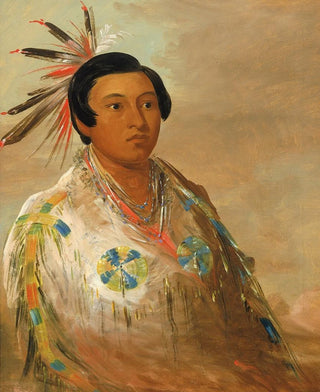Painting Heedohgeats of a young man - George Catlin | Art print


View from behind

Frame (optional)
In the vast panorama of American art history, the art print "Heedohgeats un jeune homme" by George Catlin stands out for its elegance and depth. This painting, which captures the essence of a young man from the Sioux tribe, transports us to a world where traditions and cultural identities intertwine. Through this art print, the viewer is invited to contemplate not only the image of an individual but also the heritage of a rich and complex culture. Catlin, a true pioneer, immortalized the lifestyles of indigenous peoples, offering a valuable testimony of their existence during a time of upheaval.
Style and uniqueness of the work
George Catlin's style is characterized by meticulous attention to detail and a vibrant color palette that pays homage to natural beauty and the dignity of his subjects. In "Heedohgeats un jeune homme," each brushstroke seems to tell a story, with every shadow and light contributing to the creation of an atmosphere filled with serenity and strength. The posture of the young man, his frank and determined gaze, evokes both youth and the wisdom accumulated over generations. This painting is not limited to a simple representation; it is an open window to a bygone era, an invitation to delve into the spiritual and cultural universe of the Sioux. The way Catlin manages to capture the soul of his model testifies to his artistic genius, while also offering a glimpse into the values and beliefs of his time.
The artist and his influence
George Catlin, born in 1796, is often regarded as the first artist to dedicate his career to the depiction of indigenous peoples of America. His journey across the continent, during which he met and documented various tribes, was driven by a deep desire to preserve their heritage in the face of colonial expansion. Catlin did not merely paint; he was also an anthropologist, a writer, and a passionate advocate for Native American rights. His work has not only influenced his contemporaries but continues to inspire generations of artists and historians.

Matte finish

View from behind

Frame (optional)
In the vast panorama of American art history, the art print "Heedohgeats un jeune homme" by George Catlin stands out for its elegance and depth. This painting, which captures the essence of a young man from the Sioux tribe, transports us to a world where traditions and cultural identities intertwine. Through this art print, the viewer is invited to contemplate not only the image of an individual but also the heritage of a rich and complex culture. Catlin, a true pioneer, immortalized the lifestyles of indigenous peoples, offering a valuable testimony of their existence during a time of upheaval.
Style and uniqueness of the work
George Catlin's style is characterized by meticulous attention to detail and a vibrant color palette that pays homage to natural beauty and the dignity of his subjects. In "Heedohgeats un jeune homme," each brushstroke seems to tell a story, with every shadow and light contributing to the creation of an atmosphere filled with serenity and strength. The posture of the young man, his frank and determined gaze, evokes both youth and the wisdom accumulated over generations. This painting is not limited to a simple representation; it is an open window to a bygone era, an invitation to delve into the spiritual and cultural universe of the Sioux. The way Catlin manages to capture the soul of his model testifies to his artistic genius, while also offering a glimpse into the values and beliefs of his time.
The artist and his influence
George Catlin, born in 1796, is often regarded as the first artist to dedicate his career to the depiction of indigenous peoples of America. His journey across the continent, during which he met and documented various tribes, was driven by a deep desire to preserve their heritage in the face of colonial expansion. Catlin did not merely paint; he was also an anthropologist, a writer, and a passionate advocate for Native American rights. His work has not only influenced his contemporaries but continues to inspire generations of artists and historians.
12,34 €






